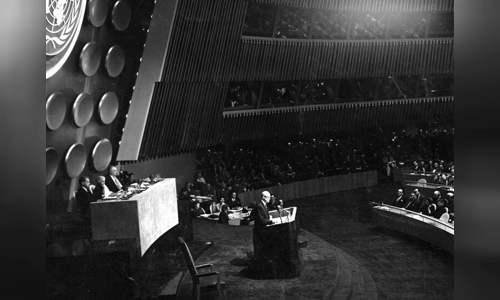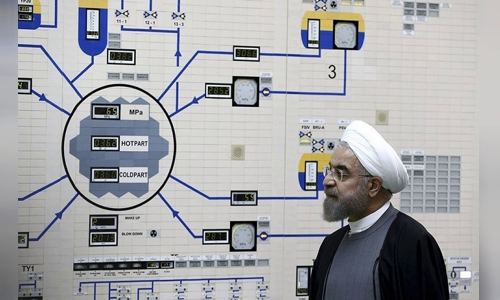The United States has always opposed Iran becoming a nuclear power, but it was Washington that brought it to Tehran more than half a century ago.
Iran on November 6 began pumping uranium gas into the centrifuges at the Fordow plant, marking a new step in a nuclear program that was strongly opposed by the United States. However, it is the United States that has brought nuclear technology to Iran, helping it implement a nuclear program that is much older than former President Obama.

US President Dwight D Photo: NPR
"Iran's nuclear program dates back to 1957 and is funded by the United States with a 5-megawatt research reactor currently operating normally in Tehran," said Ali Vaez, senior Iran analyst at the Organization. International Crisis, said.
The United States built that nuclear reactor in 1967 at Tehran University, and fueled the reactor-level enriched uranium.
This is part of the former President Dwight D. Eisenhower's "Atomic for Peace" program, an initiative to bring civilian nuclear technologies to many countries to persuade them not to pursue a military nuclear program. .
Countries benefiting from this program include Israel, India, Pakistan and Iran, then under the rule of King Mohammad Reza Pahlavi, who received US support.
Under this program, participating countries receive a small nuclear reactor and a fuel source for the reactor. At that time, Iran had enough financial resources to exploit new knowledge about nuclear technology, newly equipped and developed by a team of scientists.
The Pahlavi government paid tuition for dozens of Iranian students to the Massachusetts Institute of Technology (MIT) in the United States to study nuclear engineering in the mid-1970s, MIT said.
The majority of these people later returned home and became the core of the Iran nuclear program. It was then that the US felt that they seemed to have made a mistake. They fear that Iran will find ways to build nuclear weapons.
U.S. diplomats began negotiating in the late 1970s to limit Iran's nuclear program. However, King Pahlavi insisted that Iran had the right to own nuclear power like any other nation. Later, Iran signed contracts to build nuclear plants with West Germany and France.
Following the overthrow of King Pahlavi in 1979 and a new Islamic government led by Supreme Leader Ruhollah Khomeini, Iran's nuclear program was not taken seriously by the new regime. Khomeini once said that the nuclear plants in Bushehr should be used as wheat storage and vowed to abandon costly nuclear energy programs in Iran, which has large oil reserves.
However, things changed in the 1980s, when Iran participated in a fierce battle with neighboring Iraq led by Saddam Hussein. During the war, the Iraqi air force repeatedly bombed the decommissioned nuclear facility in Bushehr.
The war, which lasted from 1980 to 1988, left Iran with a serious shortage of electricity. In the end, the Iranian leaders decided to restart the nuclear program, though the exact cause was not given.
This has led many countries to be concerned about the possibility of Iran developing nuclear weapons, but Tehran has repeatedly denied the allegations. In the early 2000s, Iran offered to discuss the future of its nuclear program, even reaching an agreement with European powers. However, the US refused to sign that agreement.
After a failed agreement, Iran began building thousands of centrifuges, used to enrich uranium.

Iranian President Hassan Rouhani visited the Bushehr nuclear plant in 2015 Photo: AP
Former Iranian President Mahmoud Ahmadinejad, who was elected in 2005, is determined to pursue a nuclear program, even as people begin to protest and the economy plummets, triggering numerous protests.
When the 2010 Obama administration's negotiations with Ahmadinejad failed, the United States and other major powers stepped up sanctions on Iran.
It was not until President Hassan Rouhani came to power in 2013 that Iranian diplomats began private talks with the United States. US diplomat William Burns, now president of the Carnegie Foundation for International Peace, led the US delegation in secret talks, saying it was "the best time to compromise".
In July 2015, Iran signed a nuclear deal with the P5 + 1 group, including the United States, France, Germany, Britain, Russia and China, called the Joint Comprehensive Plan of Action (JCPOA). Under the deal, Iran agreed to limit uranium enrichment under UN supervision in exchange for lifting economic sanctions.
At that time, foreign businesses quickly signed many cooperation agreements with Iran, most notably Airbus and Boeing's aircraft sale contracts worth billions of dollars.
By May 2018, however, Trump unilaterally withdrew from the JCPOA, arguing that the deal did not address Iran's ballistic missile program and its intervention in regional conflicts.
Trump's decision has thwarted previously-awaited trade deals and dealt a powerful blow to Iran's weakened economy. Since then, the Trump administration has consistently stated that any country importing Iranian crude oil will face US sanctions.
After the US withdrew from the JCPOA, Iran repeatedly broke its nuclear commitments under the agreement. In July, Tehran "crossed the line" of 300 kg of uranium reserve and increased its enrichment by 4.5%. Iran says it has increased low enriched uranium production from 450 grams / day to 5 kg / day.
Recently, Tehran claimed that it owned more than 500 kg of low enriched uranium, before restarting centrifuges at Fordow.
Iran insists it is a move to "urge European powers and trading partners to find a comprehensive solution for Iran, not to undermine the deal". Rouhani recently warned that Iran could continue to break its nuclear commitments by January 2020 if Europe does not help it export its oil.
However, experts say that Iran's continued disruption of its nuclear deal could be "counterproductive". Feraydoune Majlesi in Tehran said he was concerned that Iran's drastic moves could push European leaders toward the United States.
"In foreign policy, we need to give it in order to get it back. Iran is using intimidation measures and constantly giving an 'ultimatum.' The nuclear will not bring national benefits to Iran, "Majlesi said.



 TracyRoss
TracyRoss







